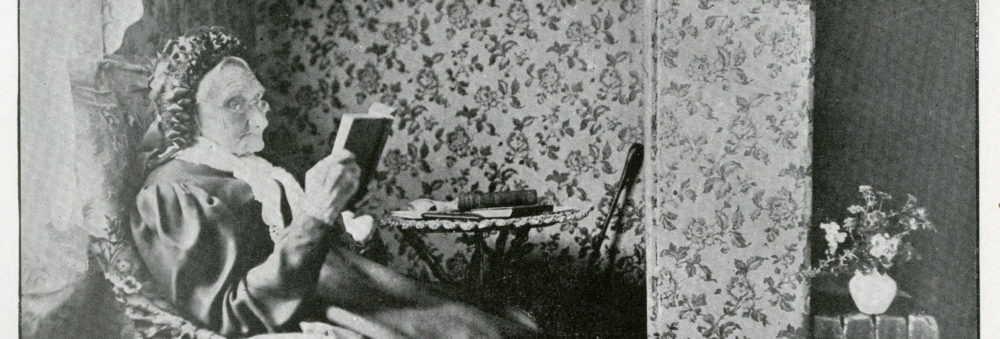By July, 1931, when Marshall Keeble preached a week-long revival in Valdosta, GA, he was already an effective and seasoned evangelist among Churches of Christ. At that time Benton Cordell Goodpasture was Minister of the Seminole Avenue Church of Christ (Atlanta, GA) and a Department Editor of Gospel Advocate, a weekly journal published in Nashville, TN.
Goodpasture attended the revival, sitting with Keeble onstage. At some point during the week he employed Connie Alderman, “an expert court reporter,” to transcribe Keeble’s sermons “exactly as delivered.” Keeble spoke so rapidly she developed muscle fatigue trying to keep up, yet the result was a volume of five simple, straightforward sermons. The book, according to Keeble biographer Edward Robinson, “catapulted Keeble to national prominence in the Stone-Campbell movement.” At the time of his death, April 20, 1968, Keeble was likely the most widely known evangelist among Churches of Christ. In 1939 Goodpasture became the editor of Gospel Advocate, a position of considerable influence he retained until his death in 1977.
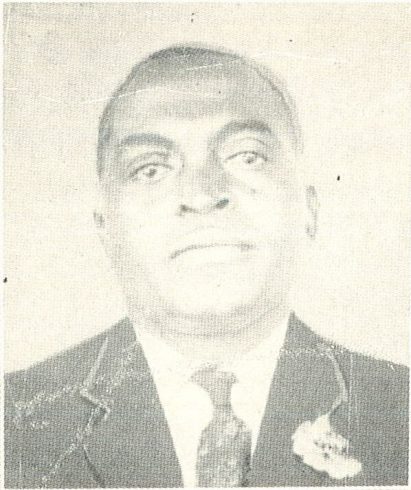
Photograph of Marshall Keeble from Goodpasture, B. C., ed. “Biography and Sermons of Marshall Keeble, Evangelist.” (Nashville: Gospel Advocate Company, 1931).
The B. C. Goodpasture Papers, housed in Center for Restoration Studies and Milliken Special Collections, contain a remarkable set of correspondence surrounding the publication of the book and its subsequent reception—across the racial divide—in Churches of Christ. Keeble and Goodpasture were household names in these churches in their lifetime, one result of the enduring legacy secured by the 1931 publication of Biography and Sermons of Marshall Keeble, Evangelist. The letters provide a fascinating window into Churches of Christ, their most recognizable white publisher, their most well-known black author, and the book they jointly produced.
Marshall Keeble left four legacies: those to whom he preached and baptized; the congregations he established; the preachers he trained and mentored; and a legacy in print consisting of books and articles. Fifty years after his death the book is still in print and still preaching. This online exhibit mirrors a physical one installed in the ACU Library in March 2018 to coincide with the 50th anniversary of Marshall Keeble’s death.
Biography and Sermons of Marshall Keeble, Evangelist, 1931 first printing, 1945 edition, and Gospel Advocate Classics Series edition of 1999
The first printing of 2,000 copies sold out in less than three weeks. By 1945, 22,000 copies were in print and by 1966 that figure reached 58,000 with an average of four copies sold per day for 35 years. In 1968 Goodpasture stated it was Gospel Advocate Company’s best-selling book. Fifty years later it is still in print.
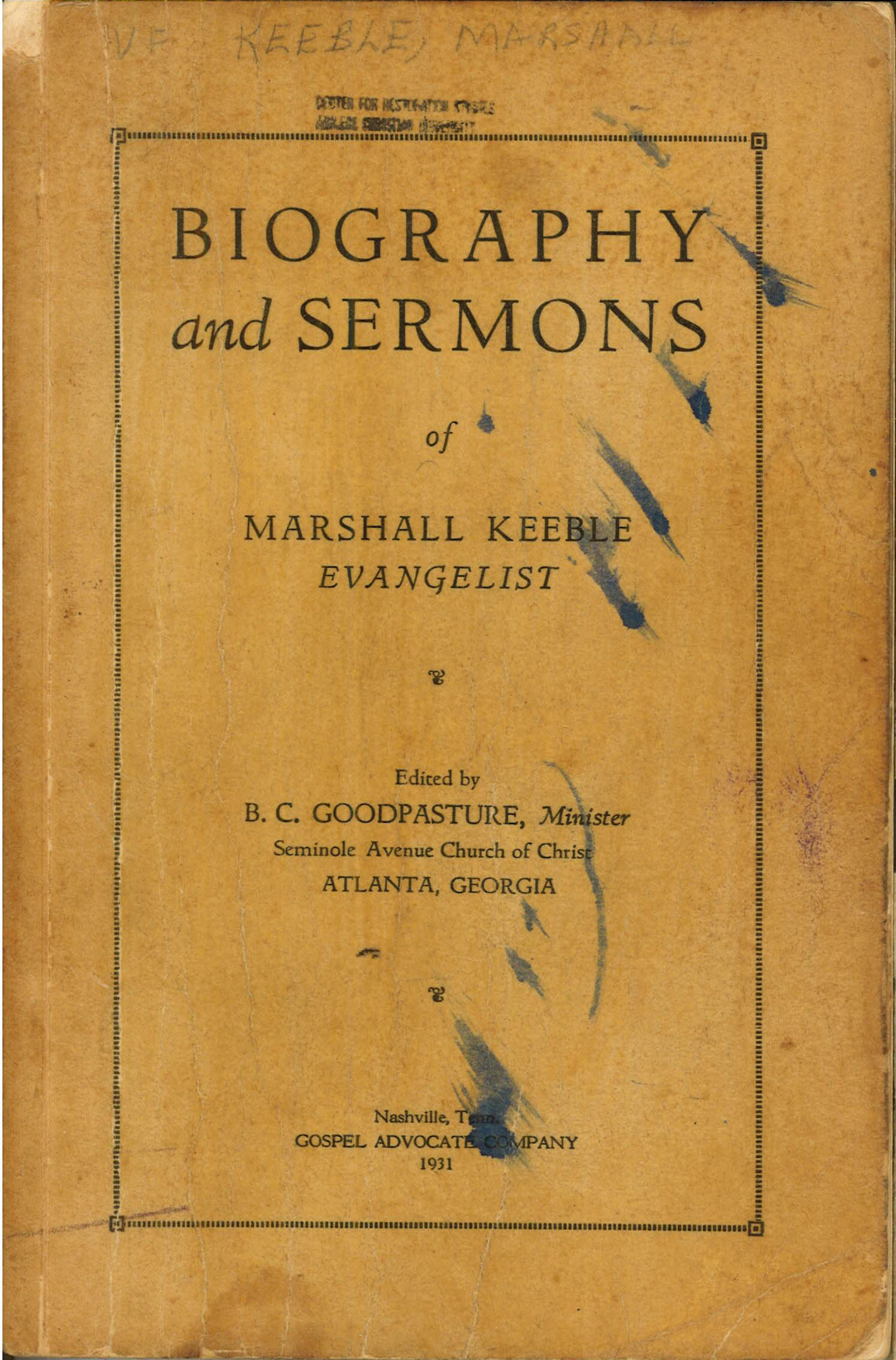
Goodpasture, B. C., ed. “Biography and Sermons of Marshall Keeble, Evangelist.” (Nashville: Gospel Advocate Company, 1931).
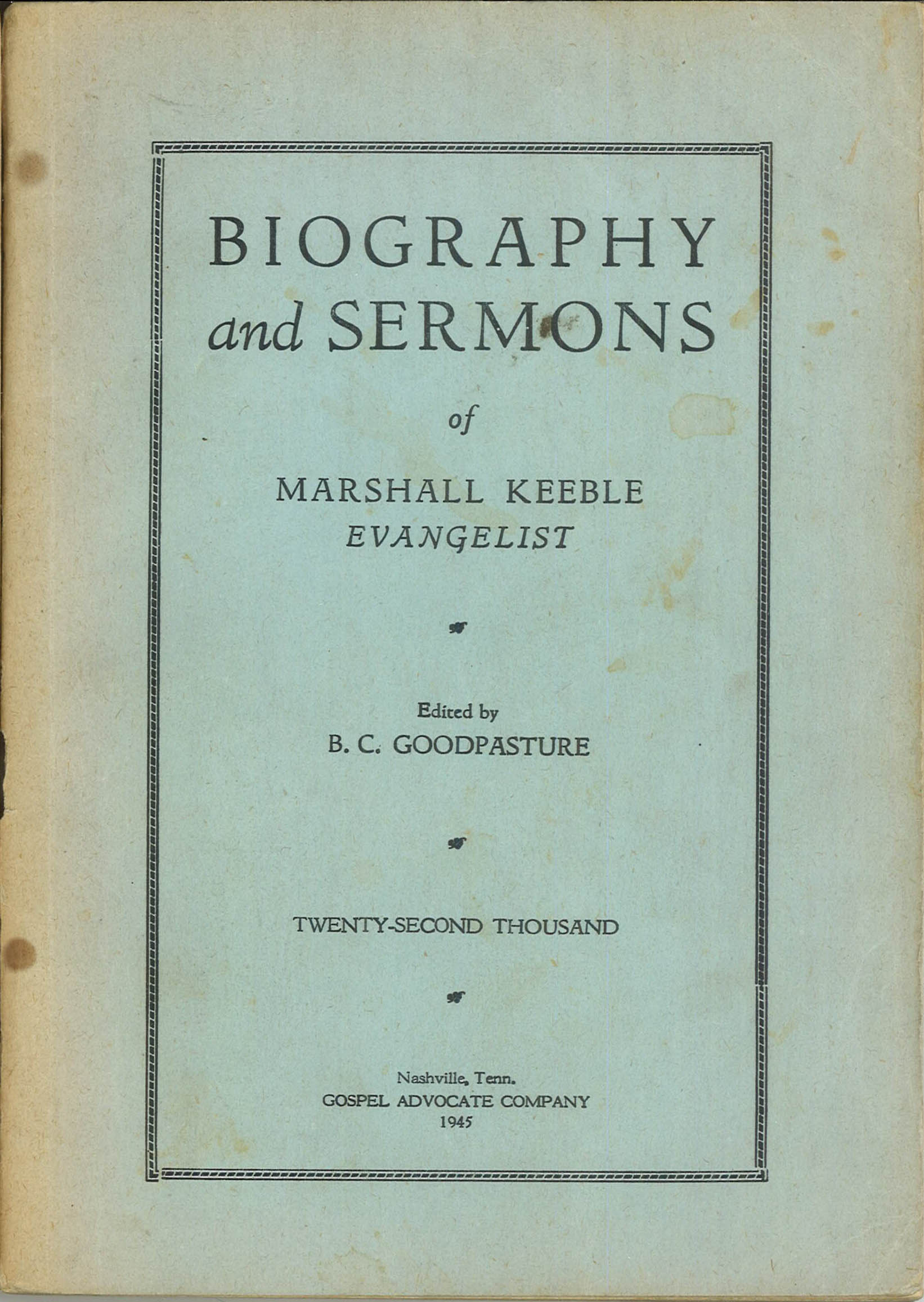
Goodpasture, B. C., ed. “Biography and Sermons of Marshall Keeble, Evangelist.” (Nashville: Gospel Advocate Company, 1945). This printing demonstrates by 1945 some 22,000 copies were in print.
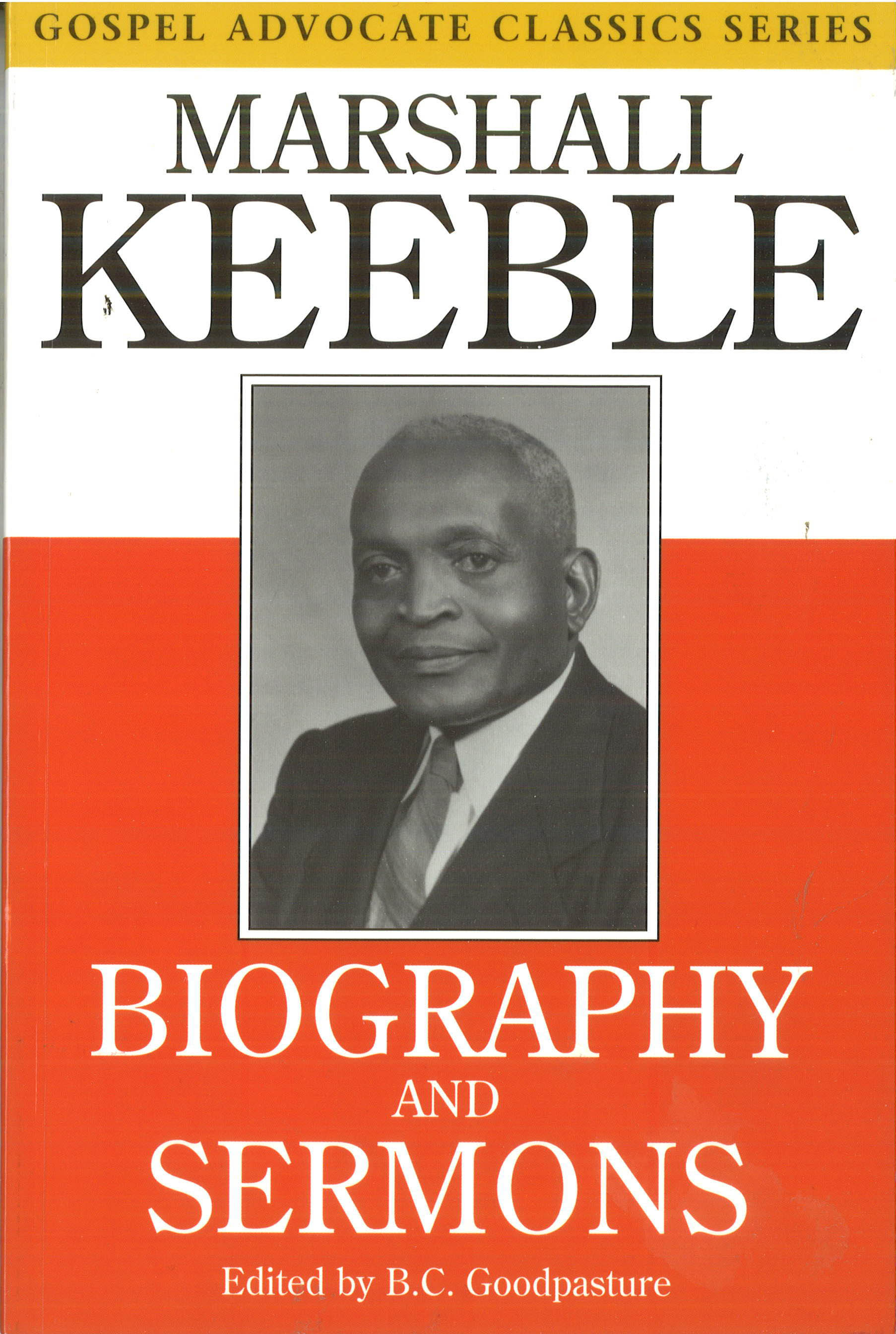
Goodpasture, B. C., ed. “Biography and Sermons of Marshall Keeble, Evangelist.” Nashville: Gospel Advocate Company, 1999.
Promotional flyer, 1932
B. C. Goodpasture used these flyers to promote book sales and to secure agents who would take sales orders. Many of the letters in the Goodpasture papers are from preachers, both white and black, who sold Keeble’s book as part of their evangelistic and outreach ministries.
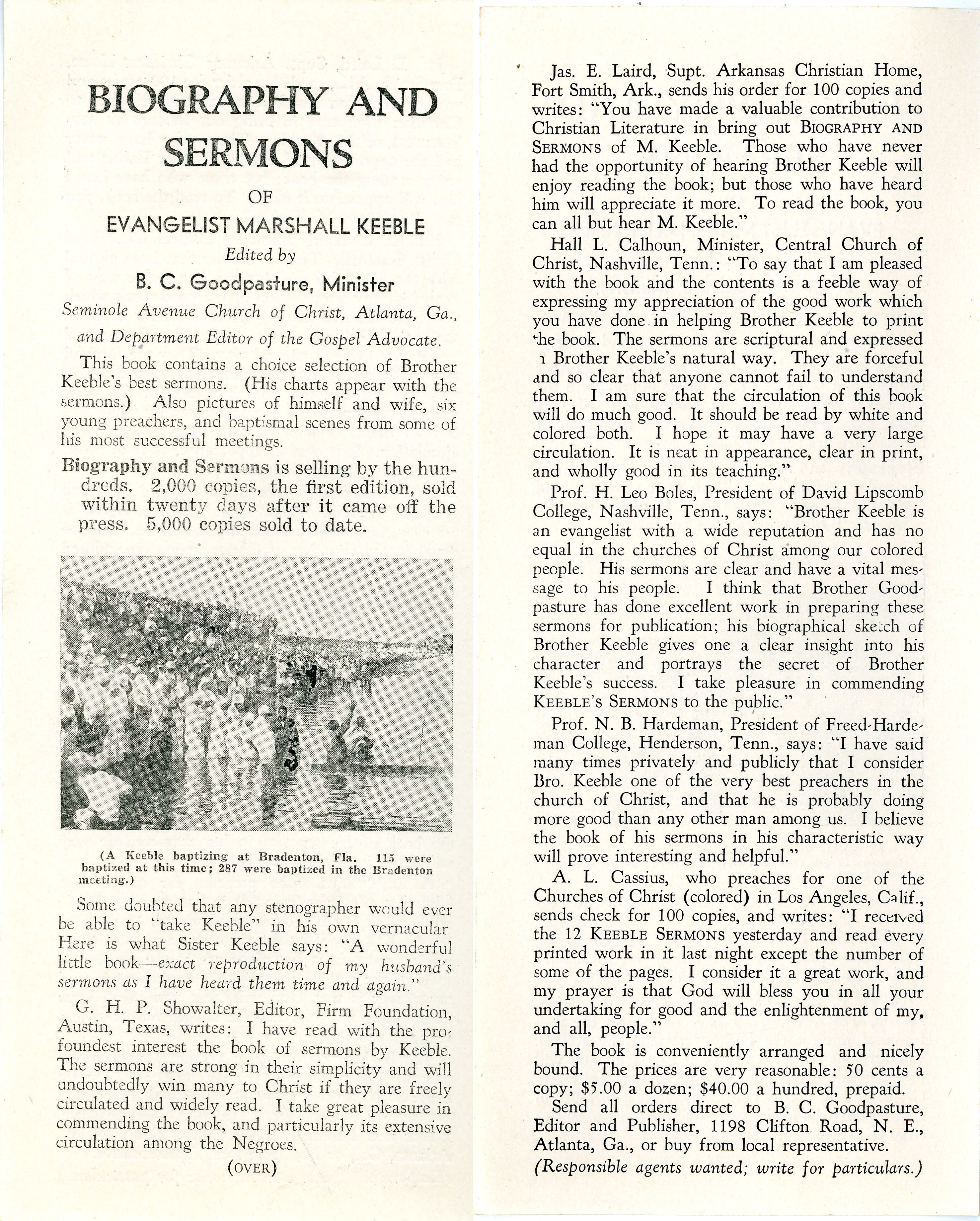
“Promotional flyer.” Folder: Marshall Keeble Biography and Sermons manuscript, Box 4, Benton Cordell Goodpasture Papers, 1854-1991. Center for Restoration Studies Manuscript #464. Milliken Special Collections, Brown Library. Abilene Christian University, Abilene, TX.
Photograph, 1931
One of the 92 immersions as a result of the revival meeting Keeble held in St. Petersburg, FL in 1931. From Biography and Sermons of Marshall Keeble. Keeble’s legacy included dozens of congregations planted, nurtured or strengthened by his preaching and teaching. He utilized the book as an evangelistic tool to further the scope and deepen the impact of his preaching.
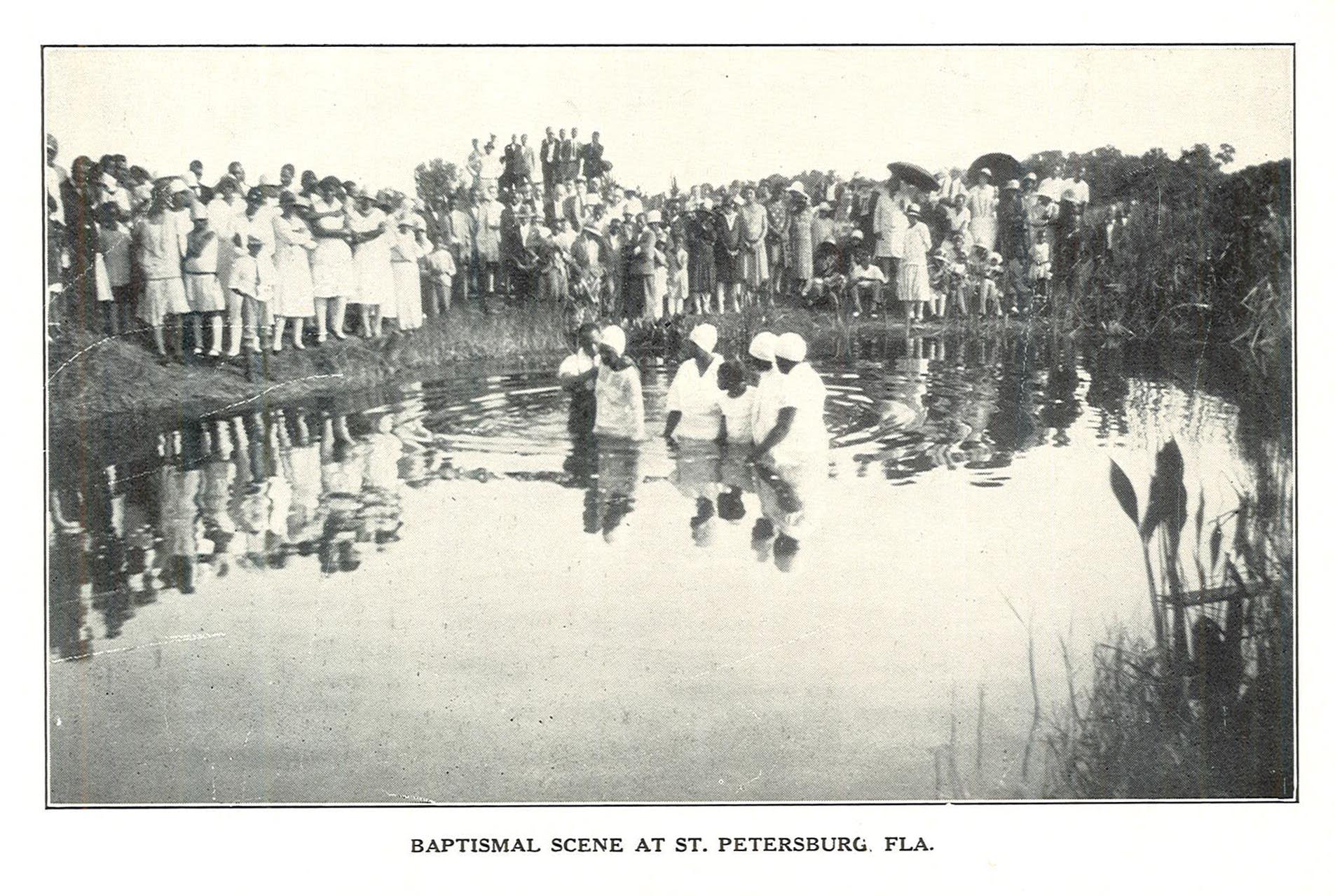
Photograph of 1931 baptismal scene at St. Petersburg, Florida. B. C. Goodpasture, ed., “Biography and Sermons of Marshall Keeble, Evangelist” (Nashville: Gospel Advocate Company, 1931), 40-41.
Photograph, circa 1945
Left to right, standing: Hassen Reed, Robert McBride. Left to right, seated: Robert Wood, Marshall Keeble, Fred Gray. Keeble’s legacy extended far beyond the printed page. As an evangelist and as President of Nashville Christian Institute, he mentored his students, such as those pictured here, by taking them to preaching appointments. Upon graduation from NCI, Fred Gray attended Western Reserve University Law School and established a law practice in Montgomery, AL at age 23. In 1955-1956 his representation of Rosa Parks against the City of Montgomery launched his career as a civil rights lawyer.
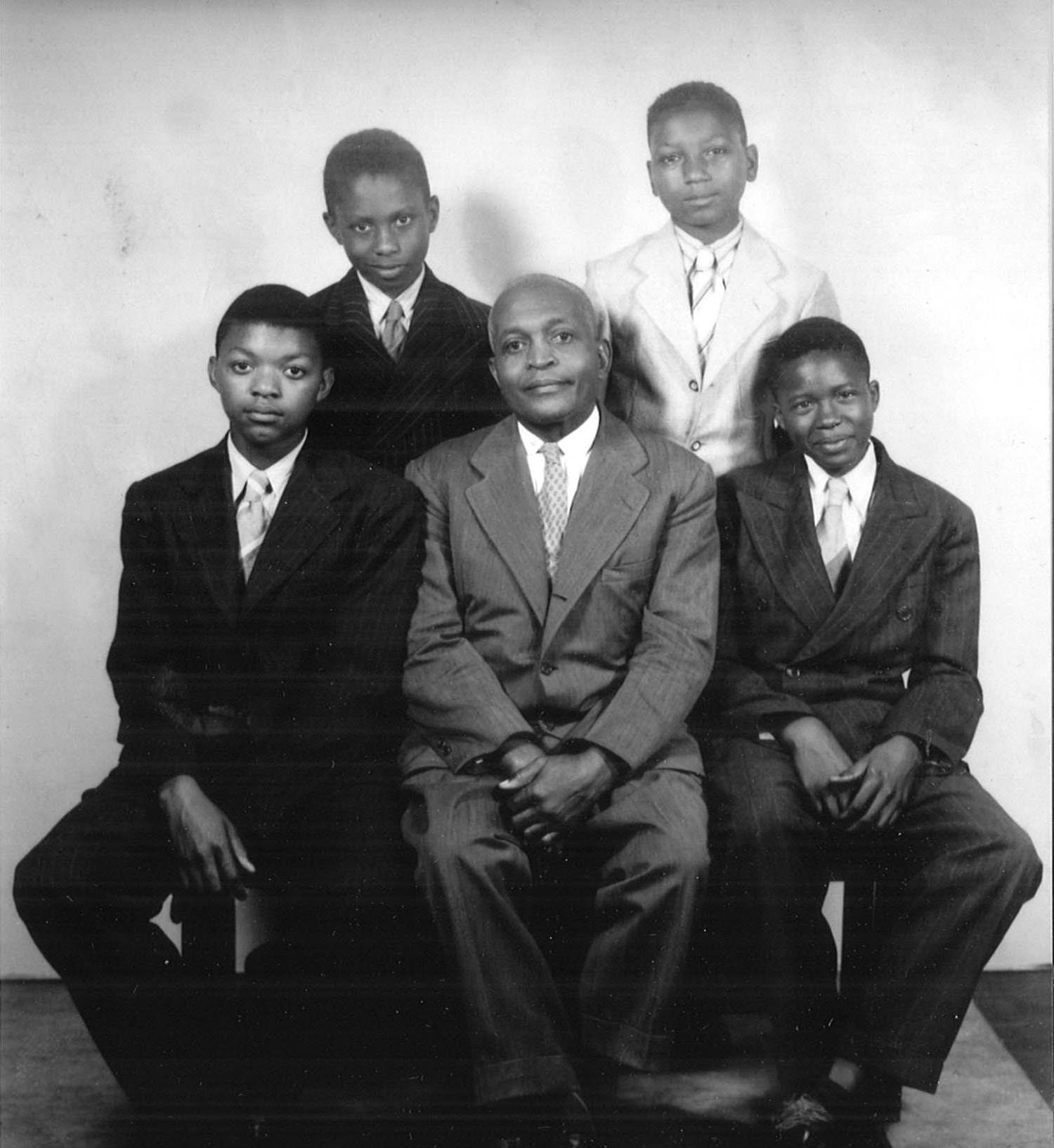
Photograph of Marshall Keeble with four boys, Marshall Keeble, Church Leaders Biographical Vertical File. Center for Restoration Studies. Milliken Special Collections, Brown Library. Abilene Christian University, Abilene, TX.
Photograph, 1931
Marshall and Minnie Womack Keeble (both age 52). From Biography and Sermons of Marshall Keeble, Evangelist. Minnie died the following year, on December 11, 1932.
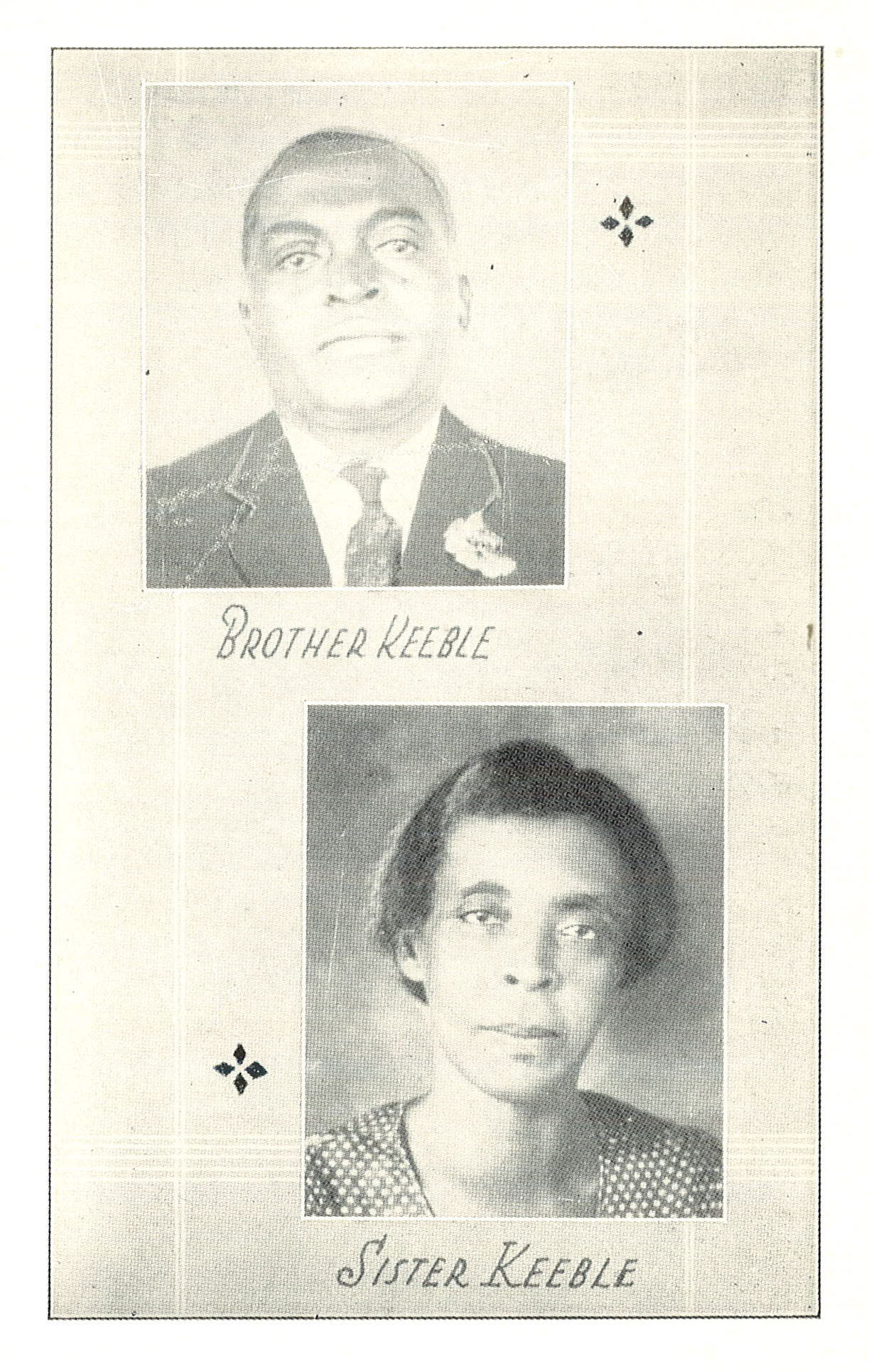
1931 photograph of Marshall Keeble and wife Minnie Womack Keeble. B. C. Goodpasture, ed., “Biography and sermons of Marshall Keeble, evangelist” (Nashville: Gospel Advocate Company, 1966), 8-9.
Letter, Marshall Keeble to B. C. Goodpasture, 30 October 1931
Keeble describes his evangelistic activities and expresses his joy over the effect the book is having across the country. “As you say,” Keeble wrote, “the book will be preaching long after you and I have gone home to get our reward.”
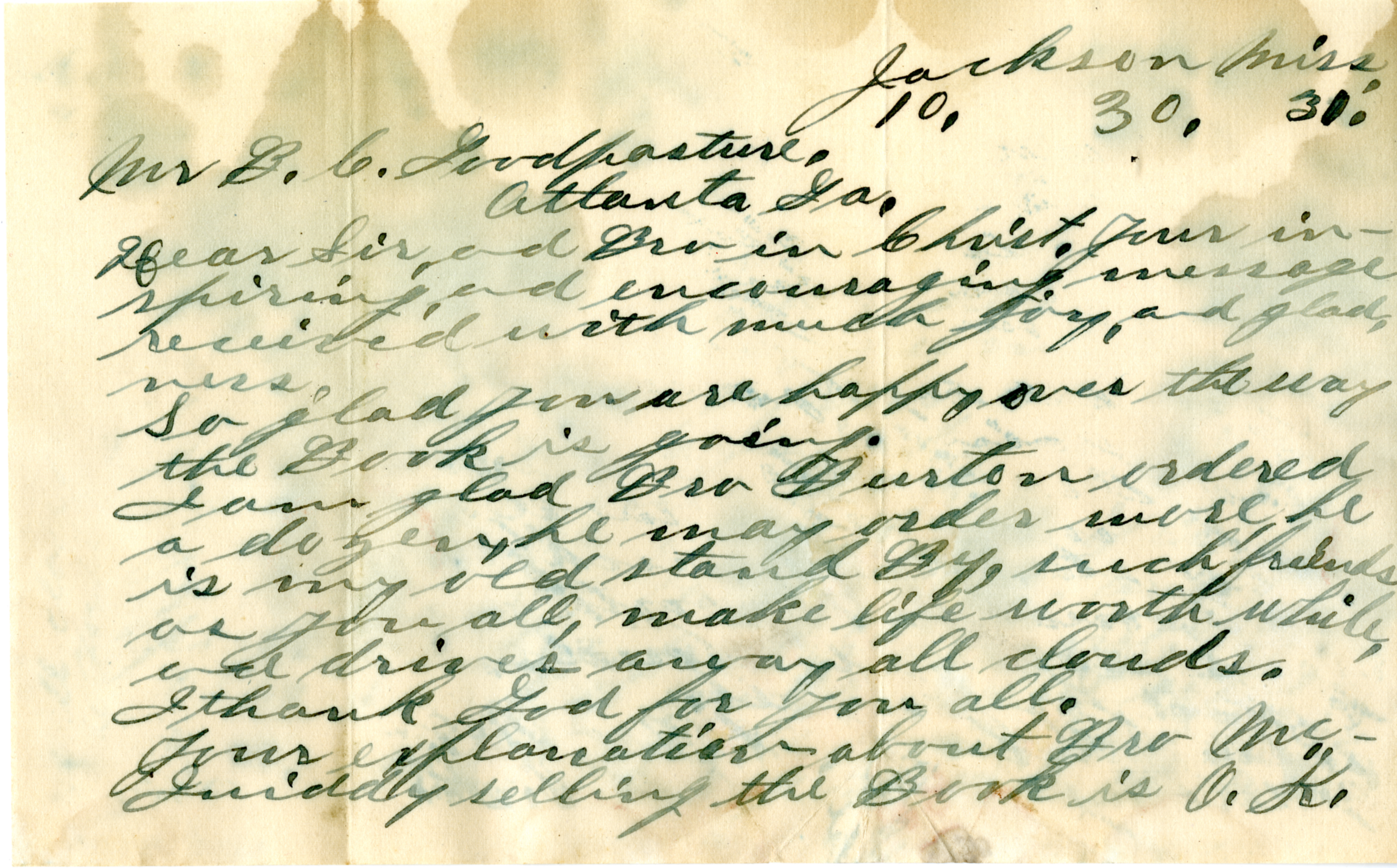
“Marshall Keeble to B. C. Goodpasture, October 30, 1931.” Folder: Marshall Keeble Biography and Sermons – 1931-1932, Box 4, Benton Cordell Goodpasture Papers, 1854-1991. Center for Restoration Studies Manuscript #464. Milliken Special Collections, Brown Library. Abilene Christian University, Abilene, TX.
Letter, Marshall Keeble to B. C. Goodpasture, 6 January 1932
The book’s rapid sale confirmed for Keeble the power of the printed page as a way to complement his preaching. Over 500 books were sold and distributed during the 1932 Los Angeles meeting described in this letter.
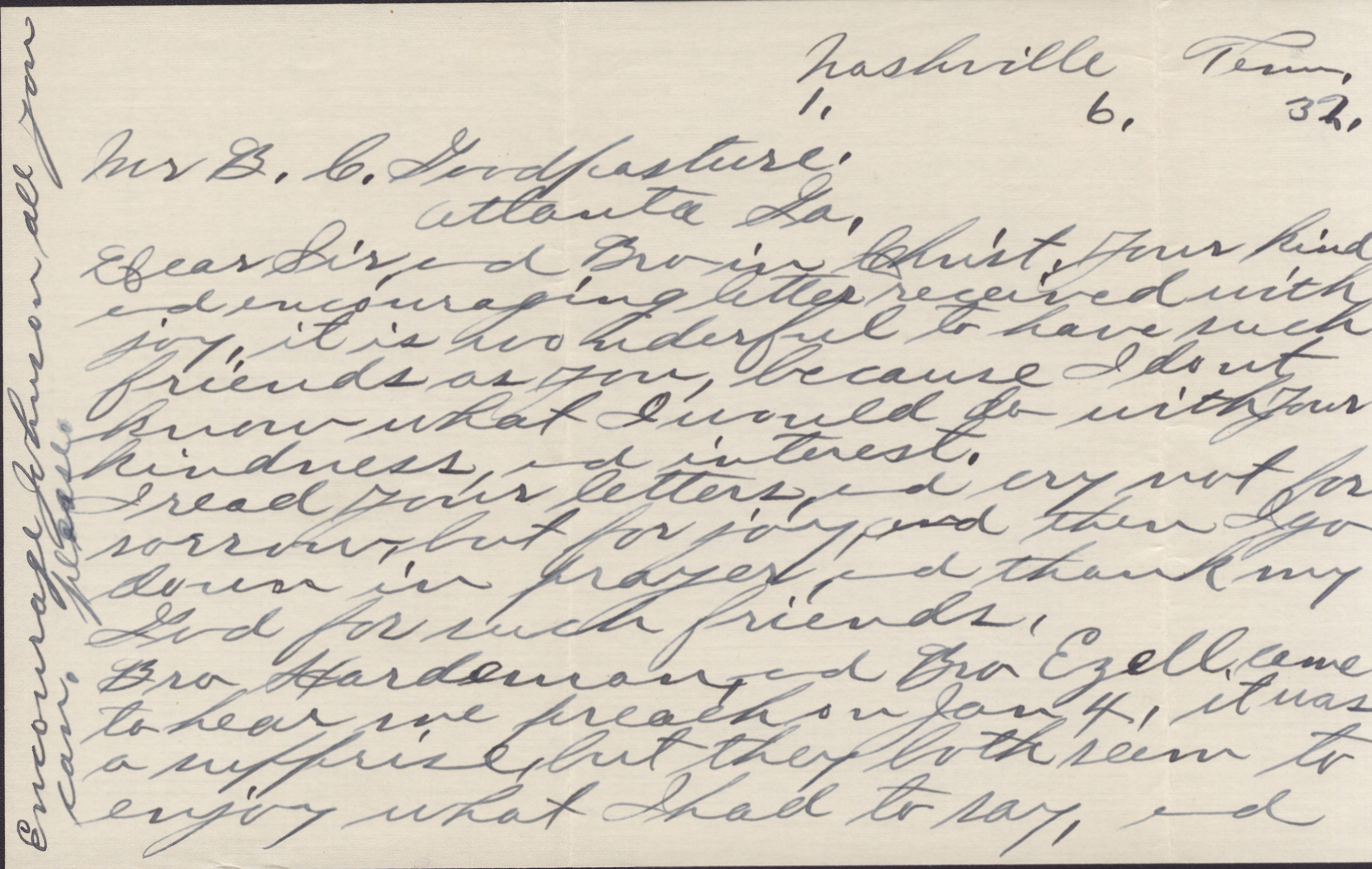
“Marshall Keeble to B. C. Goodpasture, January 6, 1932.” Folder: Marshall Keeble Biography and Sermons – 1931-1932, Box 4, Benton Cordell Goodpasture Papers, 1854-1991. Center for Restoration Studies Manuscript #464. Milliken Special Collections, Brown Library. Abilene Christian University, Abilene, TX.
Typescript draft of Biography and Sermons of Marshall Keeble, Evangelist, 1931
This draft contains annotations and corrections—some in Keeble’s hand—and additional matter not published in the final book.
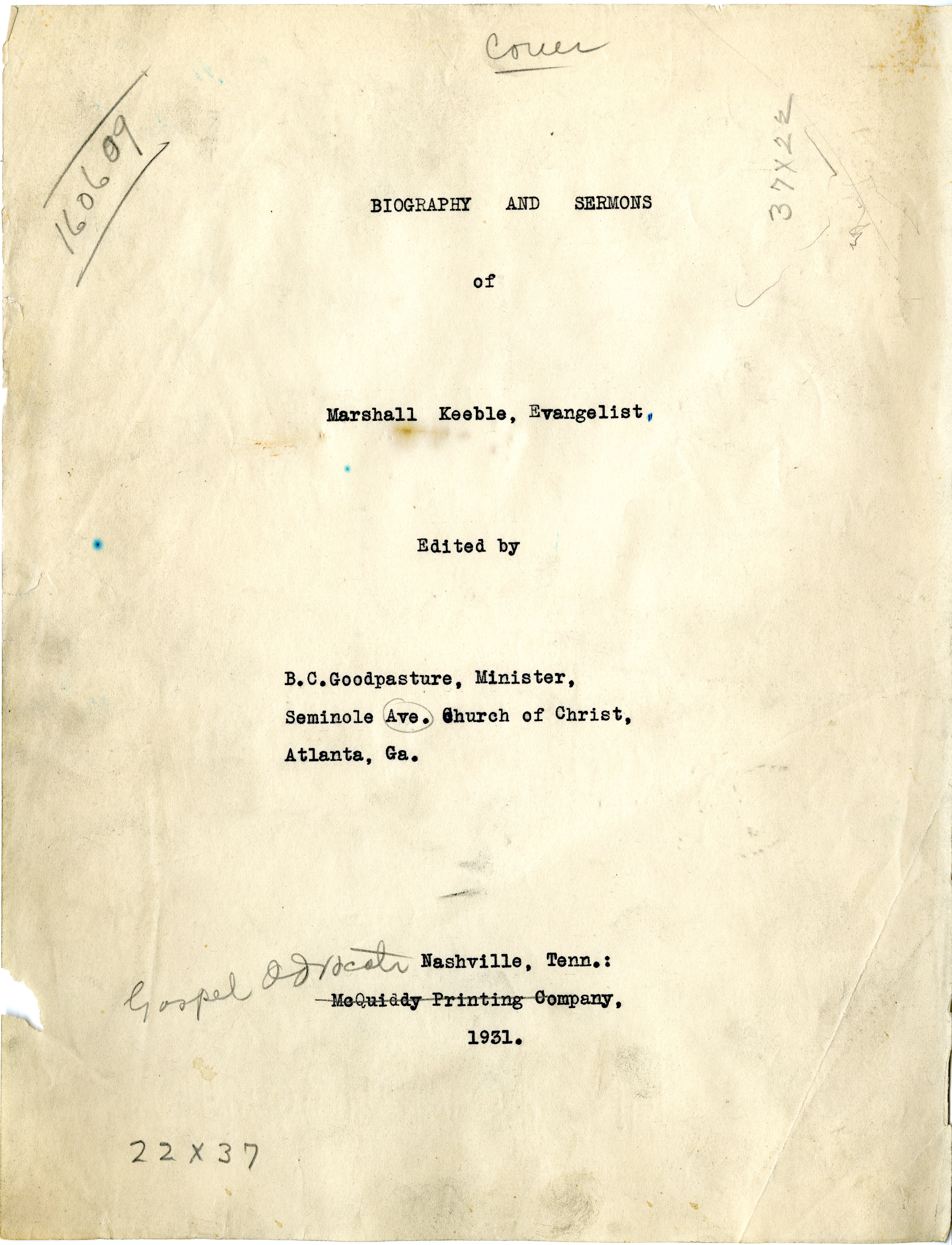
Page from typescript draft of “Biography and sermons of Marshall Keeble, evangelist,” 1931. Folder: Marshall Keeble Biography and Sermons manuscript, Box 4, Benton Cordell Goodpasture Papers, 1854-1991. Center for Restoration Studies Manuscript #464. Milliken Special Collections, Brown Library. Abilene Christian University, Abilene, TX.
Letters, 1931-1932
These letters indicate how leaders among Churches of Christ viewed Keeble and received his book. In the absence of a formal denominational structure, among Churches of Christ the colleges and periodicals held tremendous influence among preachers, church leaders, and the reading public. Endorsements from highly-regarded white leaders ensured the book’s favorable reception. Anticipating this, prior to publication Goodpasture solicited such from Calhoun, Burton, Boles, and Hardeman and included their commendations in the book. Christian Leader and Firm Foundation were periodicals of nationwide scope and circulation. Wallace, Burton, and Calhoun were likewise nationally known white leaders. A. L. Cassius was a nationally known black evangelist and church planter whose efforts in Los Angeles ensured that city became a major locus for Black Churches of Christ. Ricks, Miller and Vaughner, also pictured in the book, were leading evangelists and Keeble protégés.
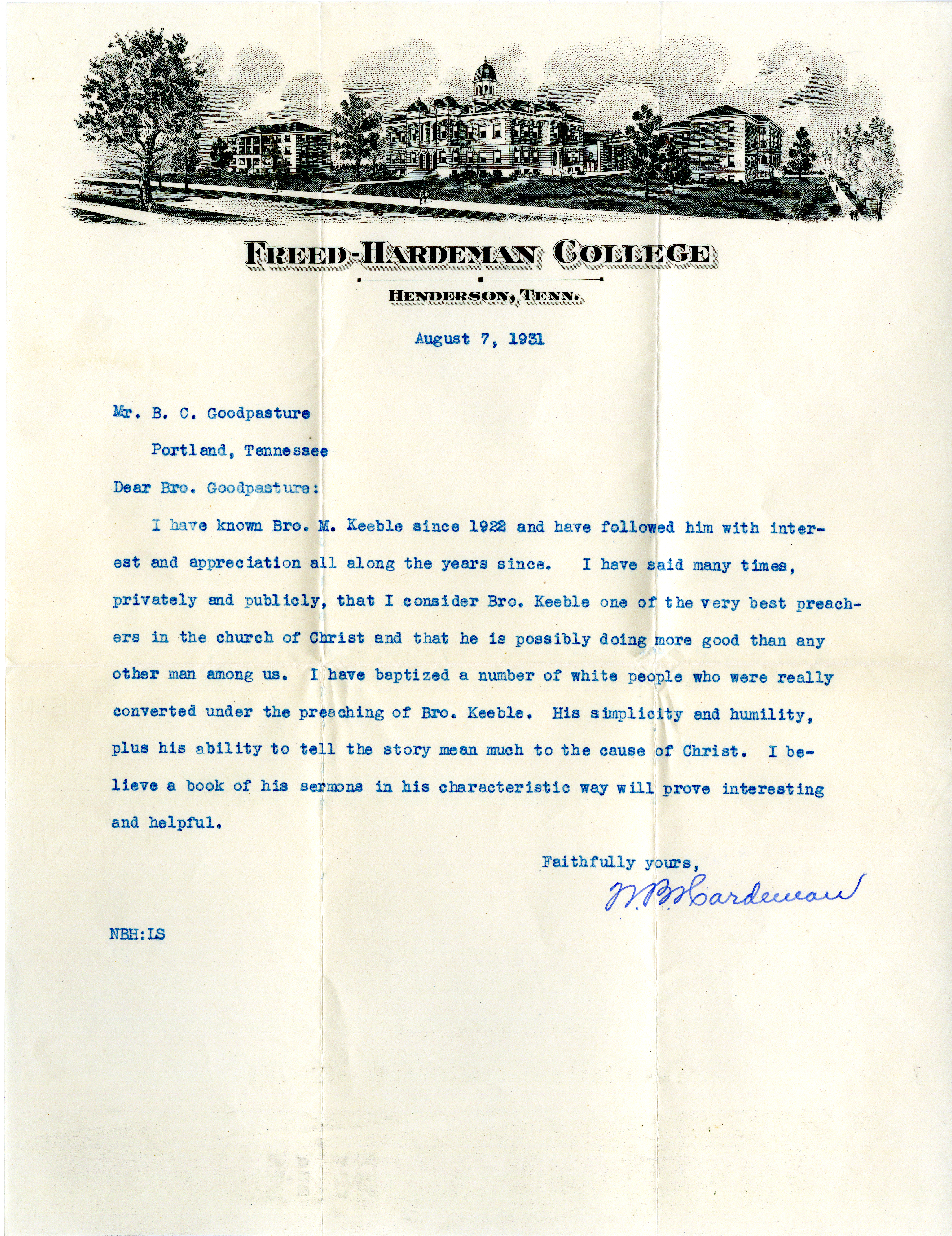
“N. B. Hardeman to B. C. Goodpasture, August 7, 1931.” Folder: Marshall Keeble Biography and Sermons – 1931-1932, Box 4, Benton Cordell Goodpasture Papers, 1854-1991. Center for Restoration Studies Manuscript #464. Milliken Special Collections, Brown Library. Abilene Christian University, Abilene, TX.
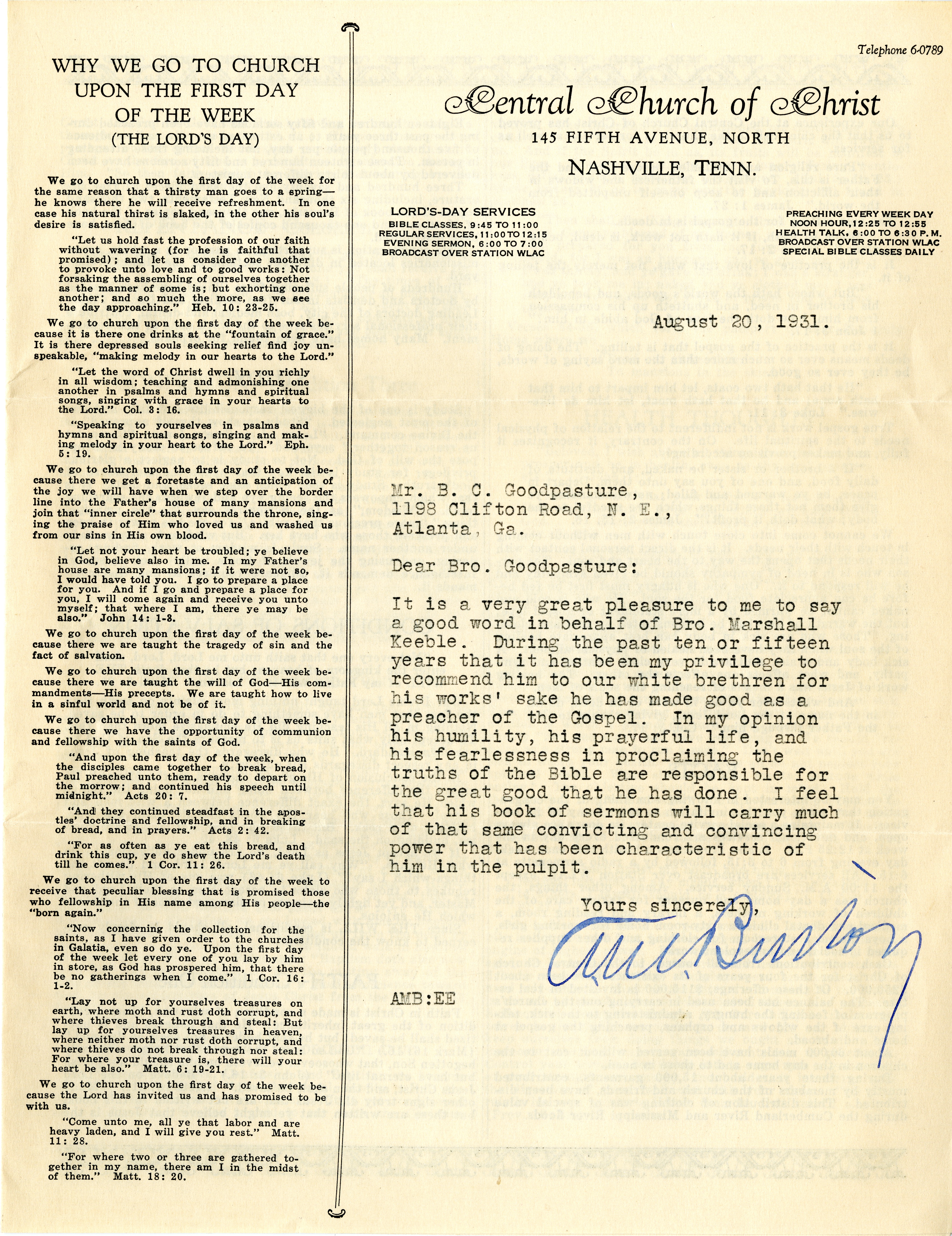
“A. M. Burton to B. C. Goodpasture, August 20, 1931.” Folder: Marshall Keeble Biography and Sermons – 1931-1932, Box 4, Benton Cordell Goodpasture Papers, 1854-1991. Center for Restoration Studies Manuscript #464. Milliken Special Collections, Brown Library. Abilene Christian University, Abilene, TX.
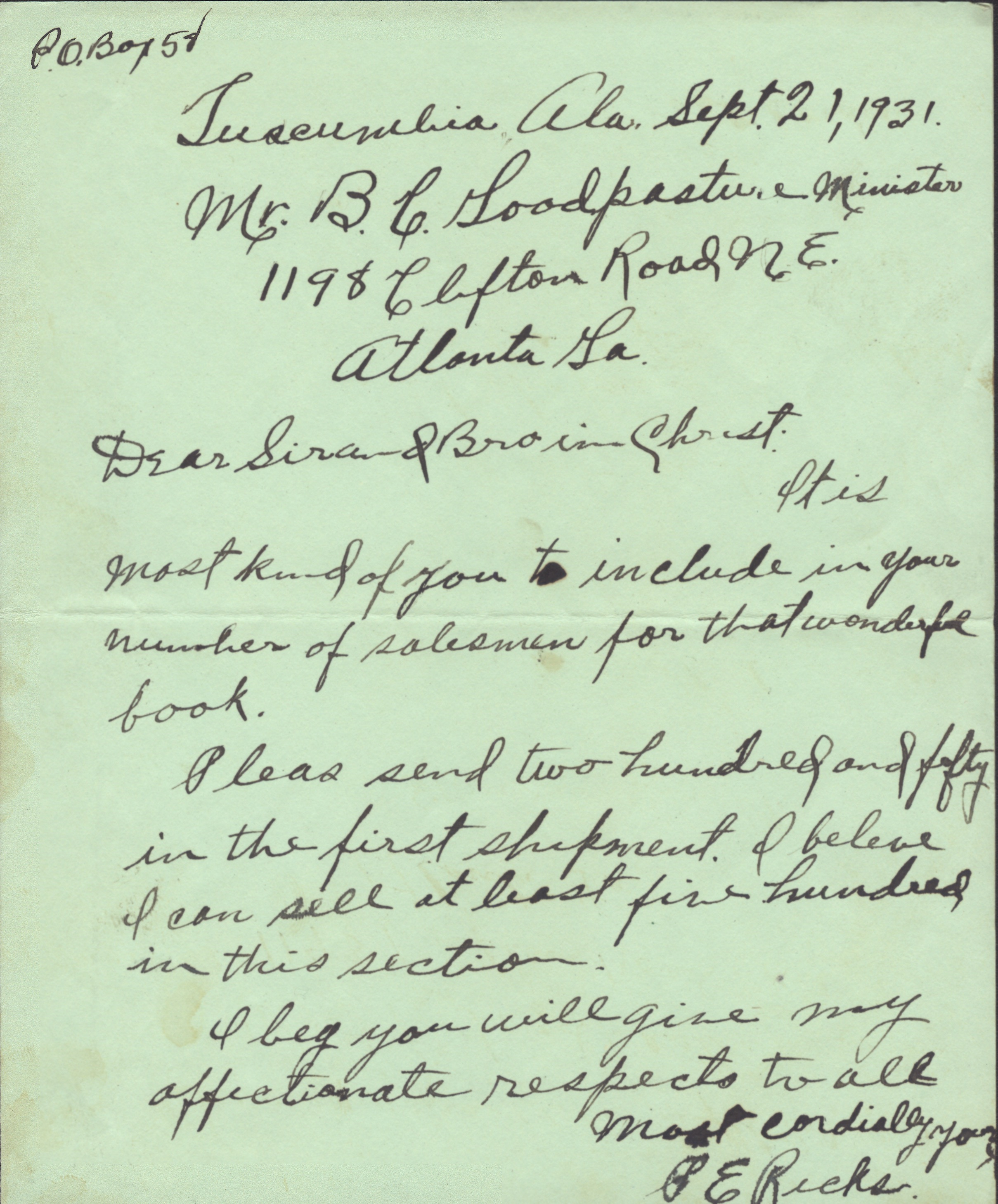
“P. E. Ricks to B. C. Goodpasture, September 21, 1931.” Folder: Marshall Keeble Biography and Sermons – 1931-1932, Box 4, Benton Cordell Goodpasture Papers, 1854-1991. Center for Restoration Studies Manuscript #464. Milliken Special Collections, Brown Library. Abilene Christian University, Abilene, TX.
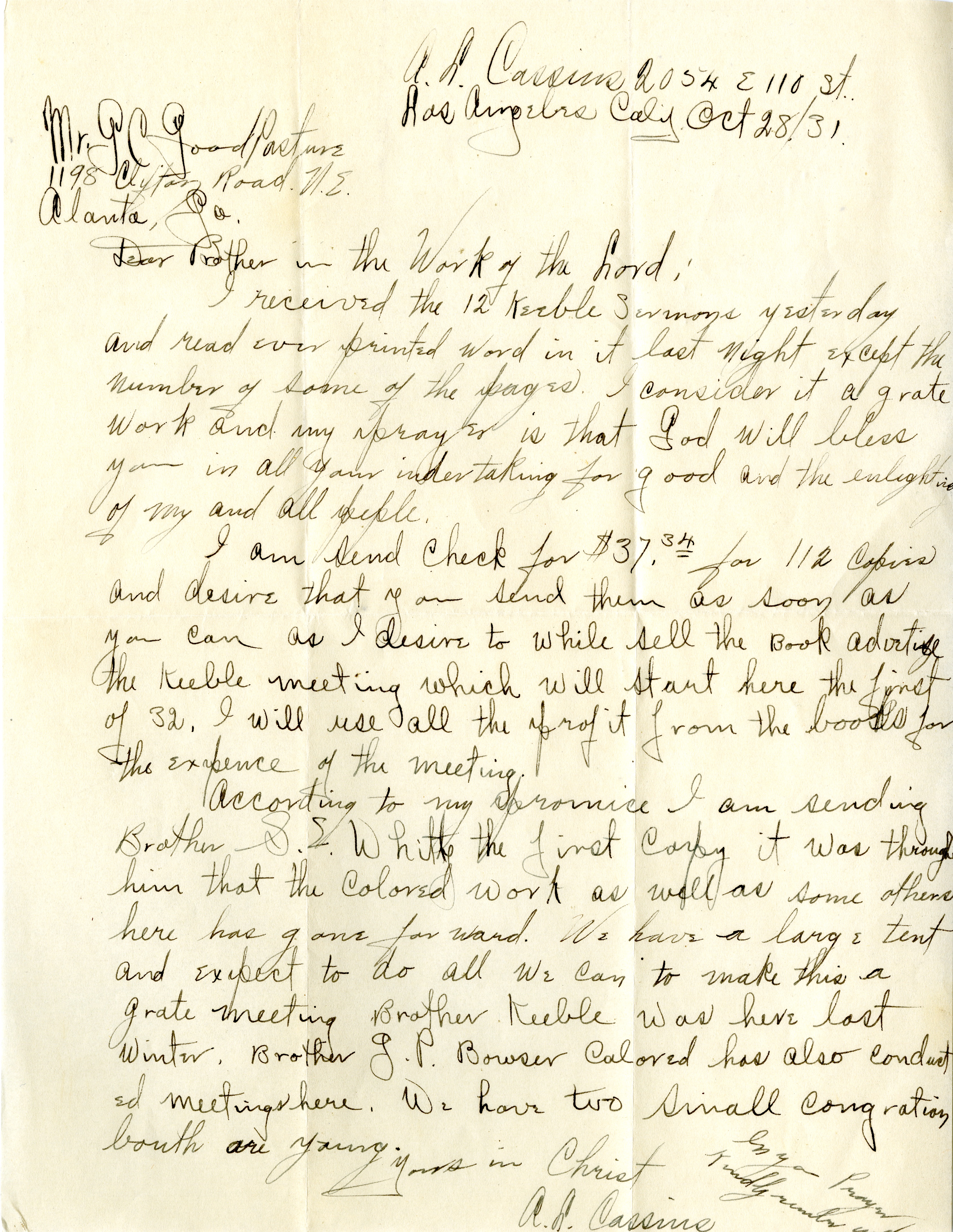
“A. L. Cassius to B. C. Goodpasture, October 28, 1931.” Folder: Marshall Keeble Biography and Sermons – 1931-1932, Box 4, Benton Cordell Goodpasture Papers, 1854-1991. Center for Restoration Studies Manuscript #464. Milliken Special Collections, Brown Library. Abilene Christian University, Abilene, TX.
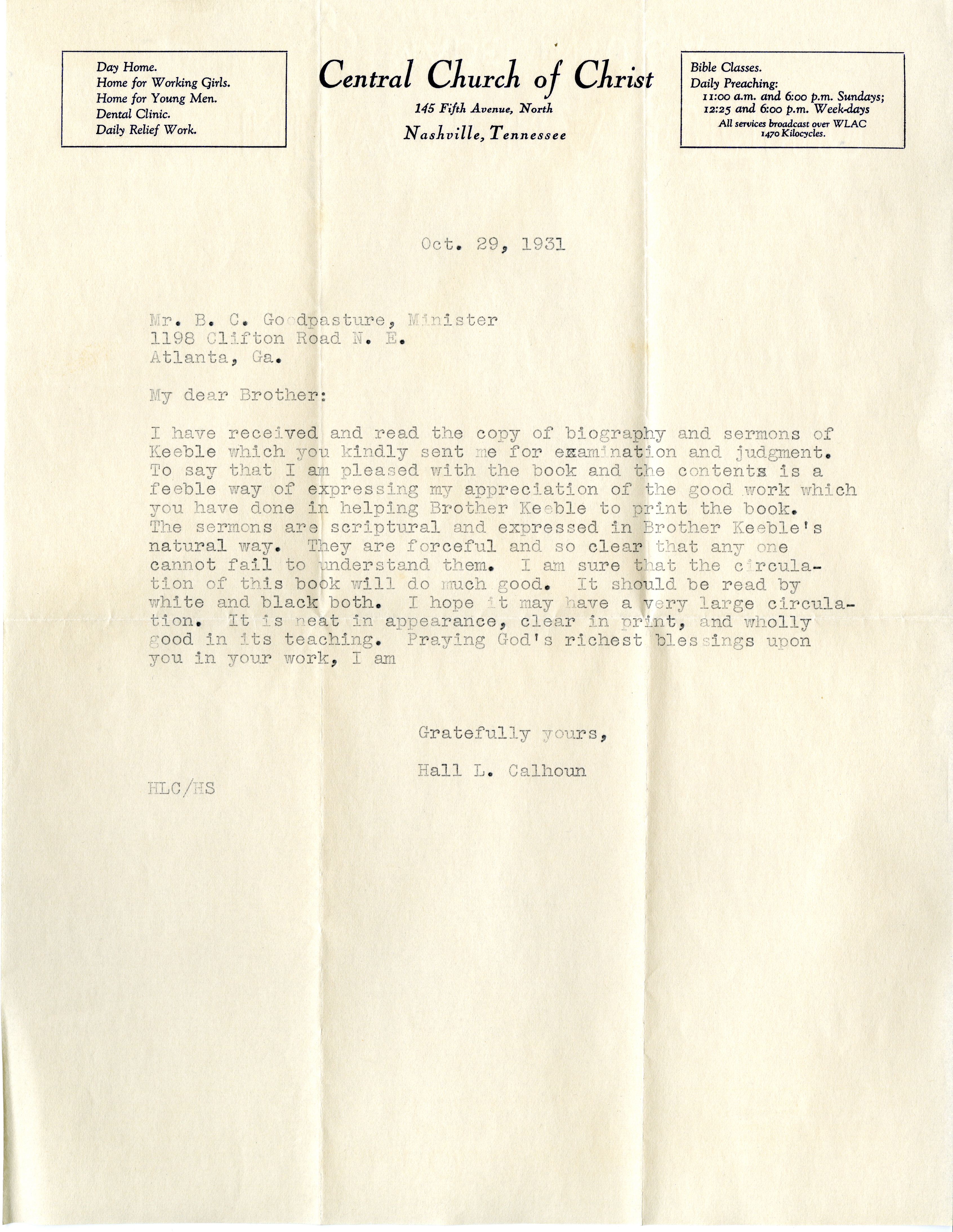
“Hall L. Calhoun to B. C. Goodpasture, October 29, 1931.” Folder: Marshall Keeble Biography and Sermons – 1931-1932, Box 4, Benton Cordell Goodpasture Papers, 1854-1991. Center for Restoration Studies Manuscript #464. Milliken Special Collections, Brown Library. Abilene Christian University, Abilene, TX.
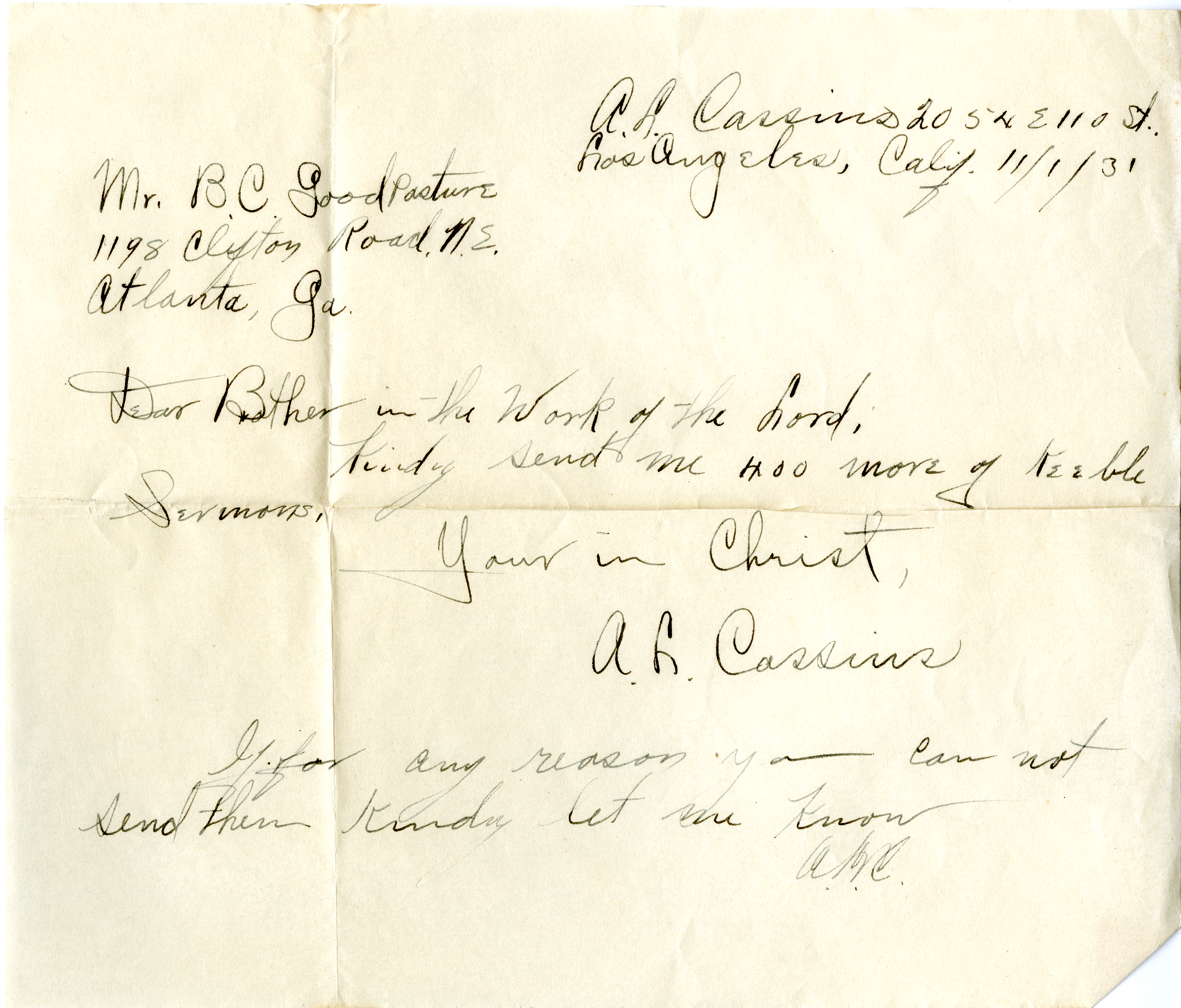
“A. L. Cassius to B. C. Goodpasture, November 1, 1931.” Folder: Marshall Keeble Biography and Sermons – 1931-1932, Box 4, Benton Cordell Goodpasture Papers, 1854-1991. Center for Restoration Studies Manuscript #464. Milliken Special Collections, Brown Library. Abilene Christian University, Abilene, TX.
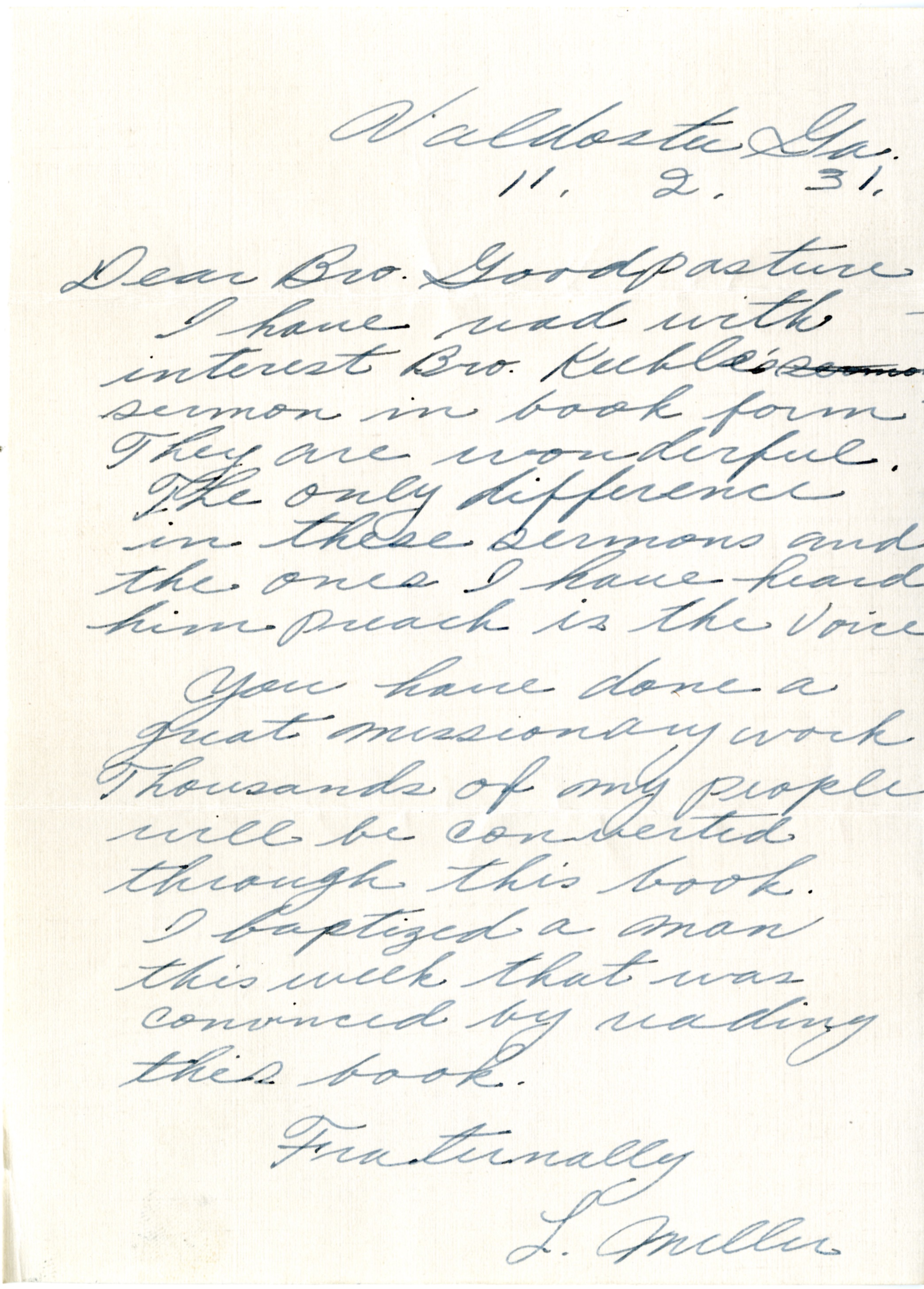
“L. Miller to B. C. Goodpasture, November 2, 1931.” Folder: Marshall Keeble Biography and Sermons – 1931-1932, Box 4, Benton Cordell Goodpasture Papers, 1854-1991. Center for Restoration Studies Manuscript #464. Milliken Special Collections, Brown Library. Abilene Christian University, Abilene, TX.
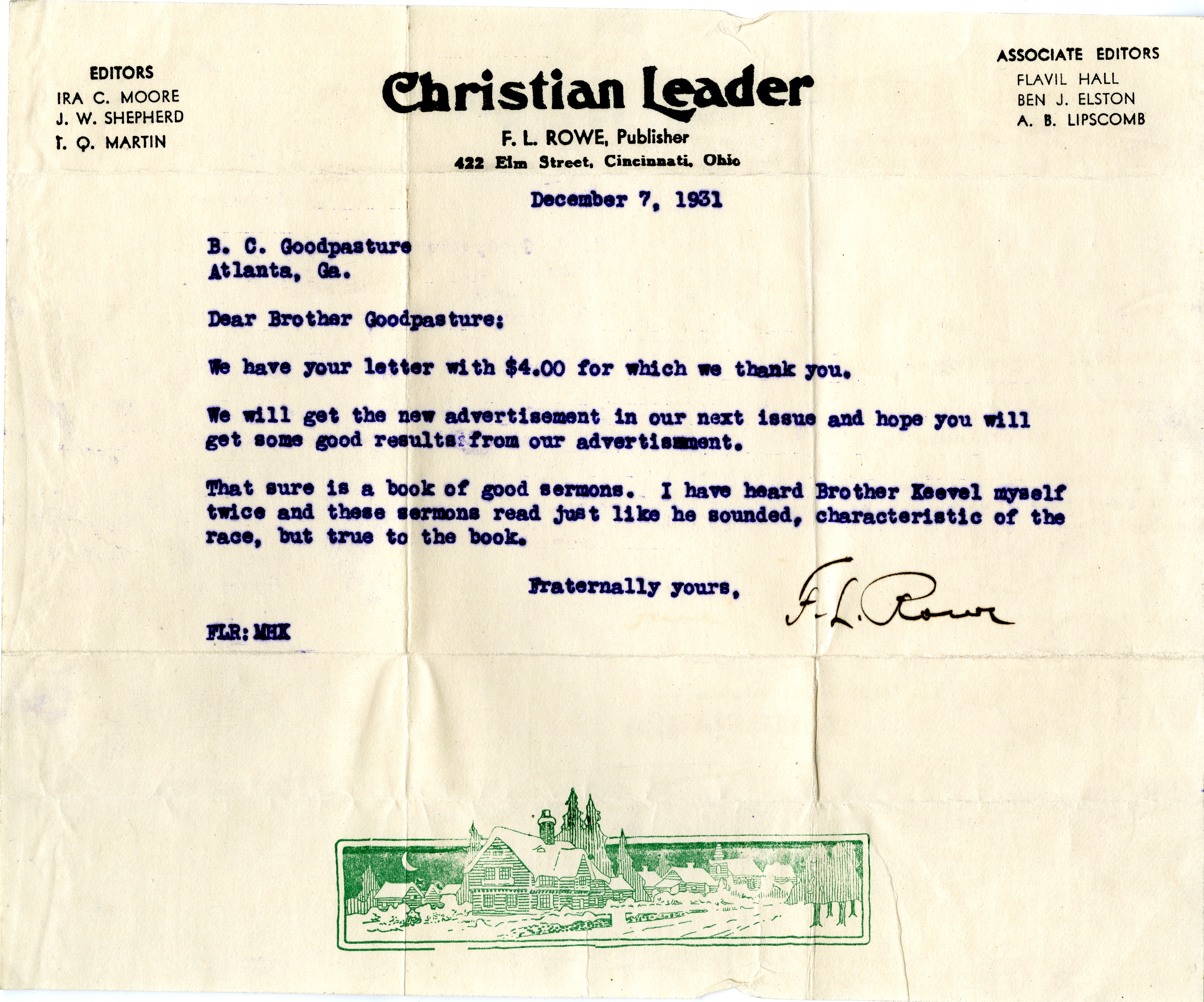
“F. L. Rowe to B. C. Goodpasture, December 7, 1931.” Folder: Marshall Keeble Biography and Sermons – 1931-1932, Box 4, Benton Cordell Goodpasture Papers, 1854-1991. Center for Restoration Studies Manuscript #464. Milliken Special Collections, Brown Library. Abilene Christian University, Abilene, TX.
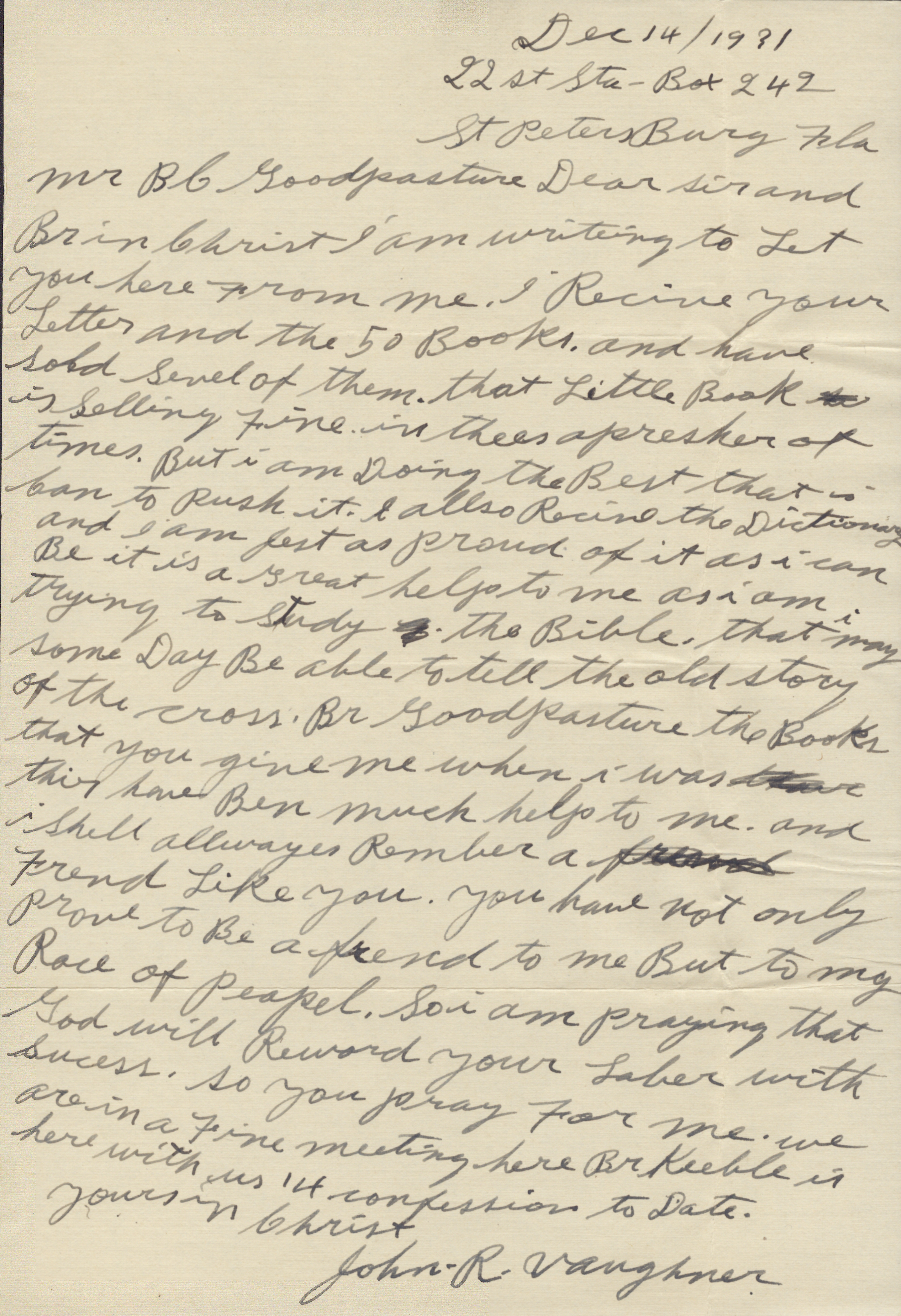
“John R. Vaughner to B. C. Goodpasture, December 14, 1931.” Folder: Marshall Keeble Biography and Sermons – 1931-1932, Box 4, Benton Cordell Goodpasture Papers, 1854-1991. Center for Restoration Studies Manuscript #464. Milliken Special Collections, Brown Library. Abilene Christian University, Abilene, TX.
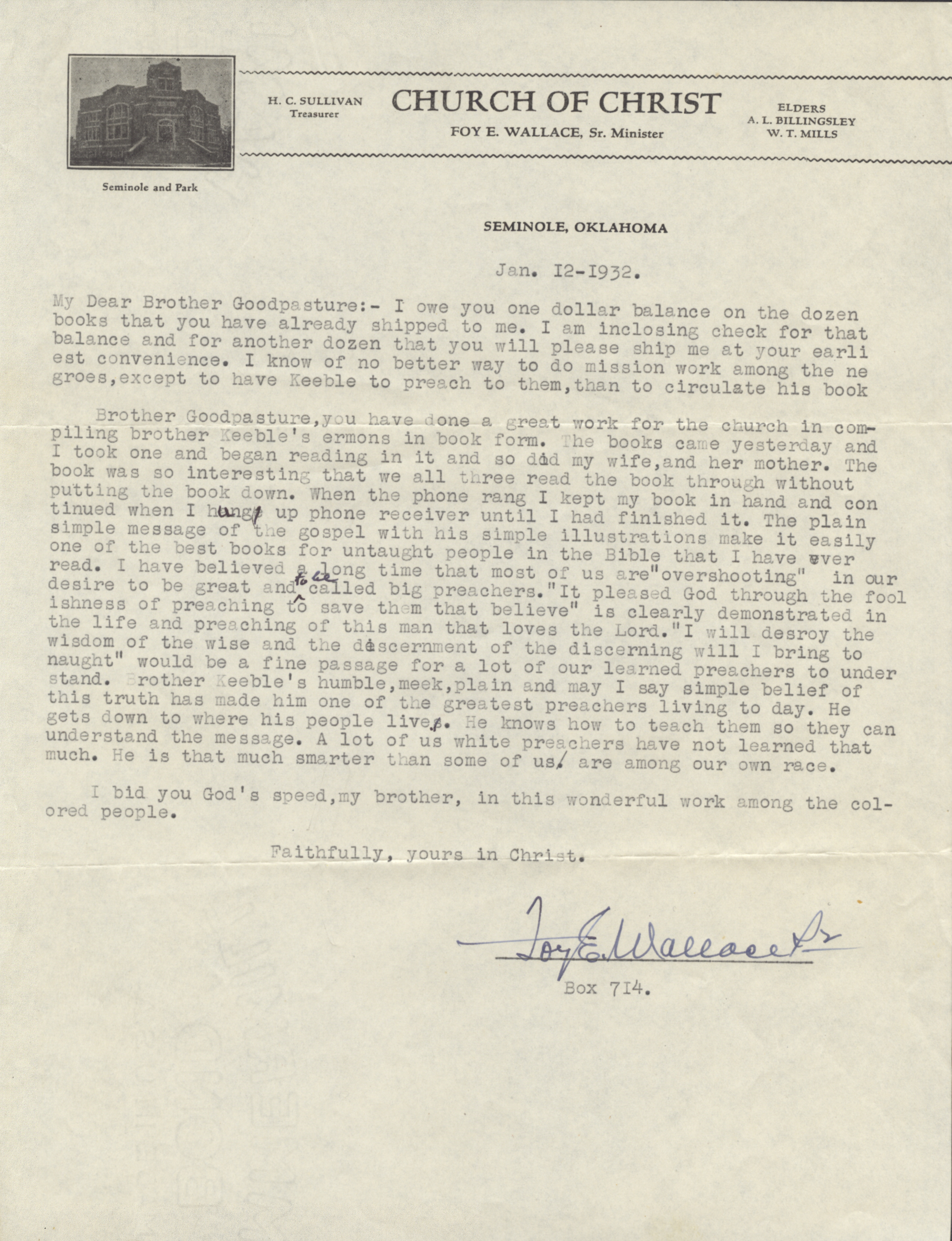
“Foy E. Wallace, Sr. to B. C. Goodpasture, January 12, 1932.” Folder: Marshall Keeble Biography and Sermons – 1931-1932, Box 4, Benton Cordell Goodpasture Papers, 1854-1991. Center for Restoration Studies Manuscript #464. Milliken Special Collections, Brown Library. Abilene Christian University, Abilene, TX.
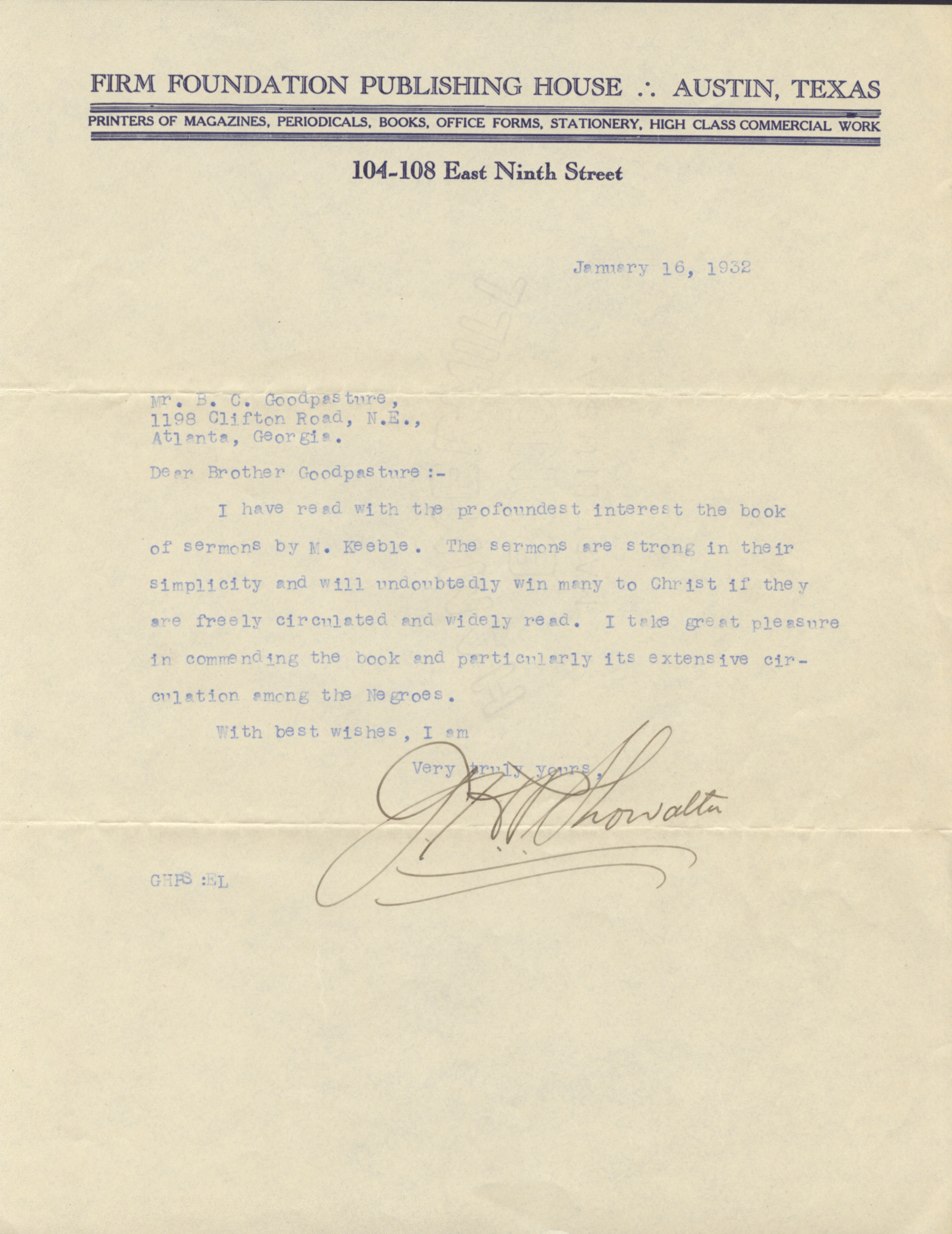
“G. H. P. Showalter to B. C. Goodpasture, January 16, 1932.” Folder: Marshall Keeble Biography and Sermons – 1931-1932, Box 4, Benton Cordell Goodpasture Papers, 1854-1991. Center for Restoration Studies Manuscript #464. Milliken Special Collections, Brown Library. Abilene Christian University, Abilene, TX.
Photograph, 1931
These six evangelists are described as Keeble’s “fellow workers” whom he “has either baptized or encouraged to preach.” One enduring legacy of Keeble’s ministry, the effects of which are still felt among many Churches of Christ today, are the hundreds of preachers he mentored. The Goodpasture Papers contain the only known surviving letters from O. L. Aker, John Vaughner, Luke Miller, and Percy Ricks. Ricks was also Keeble’s brother-in-law. The photograph is from Biography and Sermons of Marshall Keeble, Evangelist.
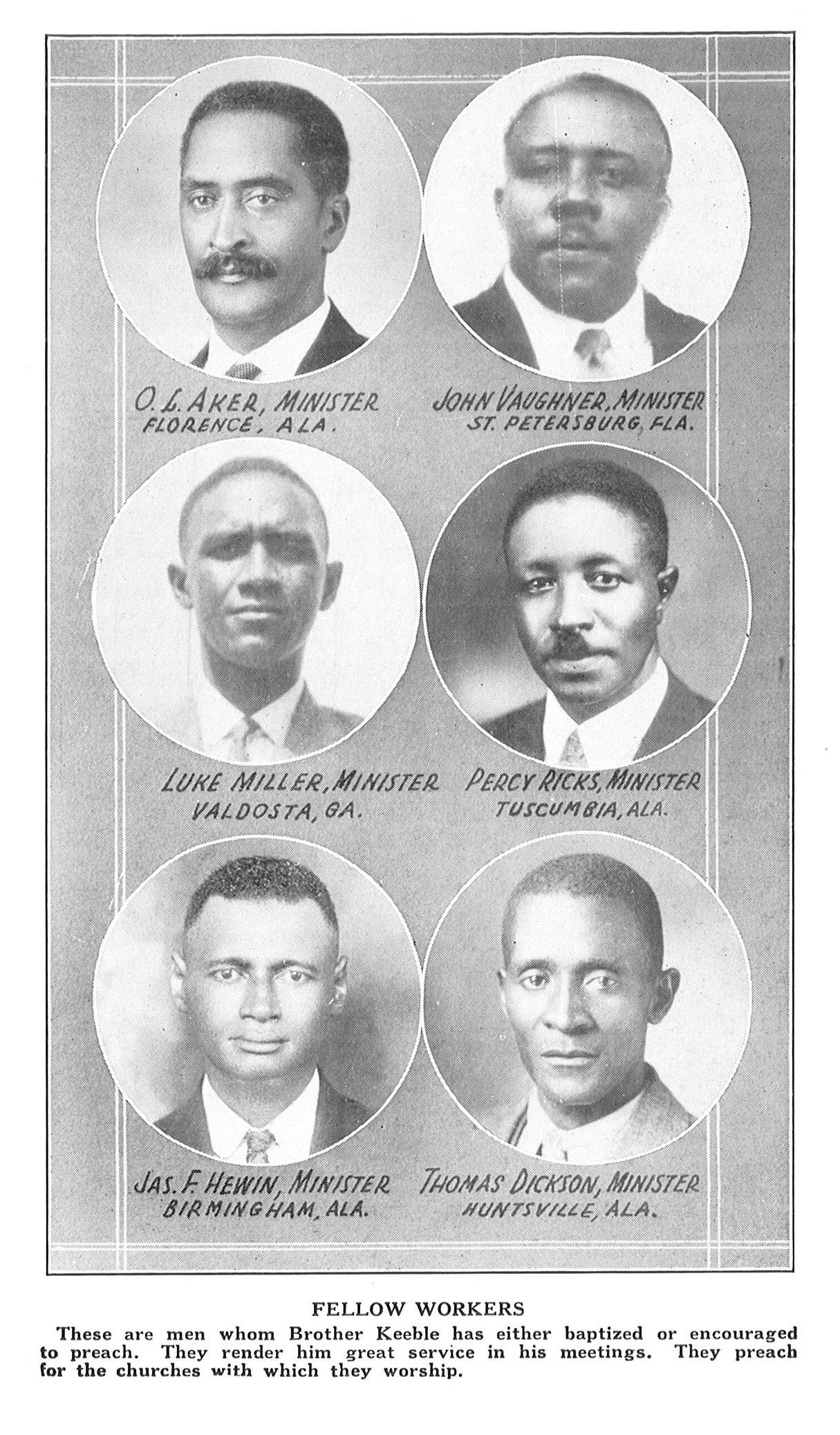
1931 photographs of men Marshall Keeble either baptized or encouraged to preach. B. C. Goodpasture, ed., “Biography and Sermons of Marshall Keeble, Evangelist” (Nashville: Gospel Advocate Company, 1931), 24-25.
Want to learn more about Marshall Keeble?
- Finding aid for the Benton Cordell Goodpasture Papers, 1854-1991 held at Center for Restoration Studies
- Articles appearing in the Gospel Advocate after the April 20, 1968 death of Marshall Keeble from History of the Restoration Movement website
- Biography of Marshall Keeble from History of the Restoration Movement website
- Marshall Keeble Historical Marker, Jackson Street at 14th Avenue North, Nashville, Tennessee from eScriptorium blog
- Athens Clay Pullias Introduces Marshall Keeble, 1948 David Lipscomb College Lectures from eScriptorium blog
- David Lipscomb College Lectures, 1948 from CHARIS contributor McGarvey Ice
Selections from Abilene Christian University Lectureship and Summit Audio Collection available at digitalcommons.acu.edu.
- Floyd Rose, “The Real Marshall Keeble – Evangelist and Educator in Church of Christ” (1997). Lectureship and Summit Audio Collection.
- Wes Crawford, “Mr. Keeble Goes to Abilene – Marshall Keeble, Racial Division and the Christian University” (2006). Lectureship and Summit Audio Collection.
- Edward J. Robinson, “Sons of Marshall Keeble: Luke Miller, John Vaughner, and James Cothron” (2005). Lectureship and Summit Audio Collection.
- Edward J. Robinson, “For Freedom You Have Been Set Free – Samuel Robert Cassius and Marshall Keeble: A Comparative Study” (2007). Lectureship and Summit Audio Collection.
- Edward J. Robinson, “The Magic Negro In Churches of Christ – Marshall Keeble’s Unique Relationship with White Churches of Christ” (2007). Lectureship and Summit Audio Collection.
- Edward J. Robinson, “Show Us How You Do It – Marshall Keeble and the Rise of the Black Churches of Christ in the United States” (2008). Lectureship and Summit Audio Collection.
Listen to Marshall Keeble here on the History of the Restoration Movement page:
- All Men One in Christ (24:50 minutes)
- The Doctor that Never Lost A Case (18:24 minutes)
- The Great Physician (19:30 minutes)
- There’s Water In The Plan (24:32 minutes)
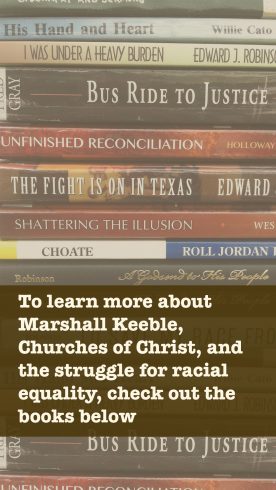
For further reading and study, consult these books from the Abilene Christian University Library:
- Cato, Willie. His Hand and Heart. Winona, Mississippi: J. C. Choate Publications, 1991.
- Choate, J. E. Roll Jordan Roll: A Biography of Marshall Keeble. Nashville: Gospel Advocate Company, 1974.
- Crawford, Wes. Shattering the Illusion: How African American Churches of Christ Moved From Segregation to Independence. Abilene, Texas: Abilene Christian University Press, 2013.
- Gray, Fred D. Bus Ride to Justice: Changing the System by the System: The Life and Works of Fred D. Gray, Preacher, Attorney, Politician. Montgomery: NewSouth Books, 2002.
- Holloway, Gary and John York. Unfinished Reconciliation : Justice, Racism, and Churches of Christ. Abilene, Texas: Abilene Christian University Press, 2013.
- Keeble, Marshall. Biography and Sermons of Marshall Keeble, Evangelist. Nashville: Gospel Advocate Company, 1959.
- Robinson, Edward J., ed. A Godsend to His people: The Essential Writings and Speeches of Marshall Keeble. Knoxville: The University of Tennessee Press, 2008.
- Robinson, Edward J. I Was Under a Heavy Burden: The Life of Annie C. Tuggle. Abilene, Texas: Abilene Christian University Press, 2011.
- Robinson, Edward J. The Fight is on in Texas: A History of African American Churches of Christ in the Lone Star State, 1865-2000. Abilene, Texas: Abilene Christian University Press, 2008.
- Robinson, Edward J. To Save My Race From Abuse: The Life of Samuel Robert Cassius. Tuscaloosa: The University of Alabama Press, 2007.
- Tuggle, Annie C. Our Ministers and Song Leaders of the Church of Christ. Detroit: Tuggle, 1945.
This exhibition was curated by Mac Ice and was on display in the ACU Library Learning Commons from March to September 2018. This digital exhibit was prepared by Amanda Dietz, March 12, 2018.
